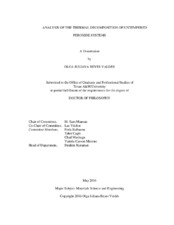| dc.contributor.advisor | Mannan, Sam | |
| dc.contributor.advisor | Vechot, Luc | |
| dc.creator | Reyes Valdes, Olga Juliana | |
| dc.date.accessioned | 2016-07-08T15:11:38Z | |
| dc.date.available | 2018-05-01T05:49:36Z | |
| dc.date.created | 2016-05 | |
| dc.date.issued | 2016-04-08 | |
| dc.date.submitted | May 2016 | |
| dc.identifier.uri | https://hdl.handle.net/1969.1/156922 | |
| dc.description.abstract | Several of the most catastrophic process safety incidents, such as Bhopal and most recently Texas West Fertilizer explosion, were initiated by runaway reactions. Consequences of such incidents include, fatalities, environmental damage, and in some instances corporate bankruptcy. To prevent conditions leading to a runaway, it is necessary to understand the kinetics, and physical and thermodynamic properties of the chemical system.
In the present research, calorimetric experiments were coupled with computational chemistry calculations to characterize the runaway behavior of two organic peroxides: Dicumyl Peroxide (DCP) and Cumene Hydroperoxide (CHP). These two reactive systems are particularly challenging due to their untempered behavior and complex kinetics. To characterize the physical behavior of DCP and CHP runaways, adiabatic testing was performed in two equipment. Experimental results suggest that:
Scaling up methods used to estimate temperature and self-heating rate profiles on a large-scale, from laboratory data, are inconsistent for fast self-heating rate systems under runaway conditions. Moreover, the use of low thermal inertia or phi factor equipment (more costly and difficult to operate), do not always provide better large-scale estimations. This is due to potential higher heat losses.
Pressure discrepancies of up to 27 times were encountered when the phi factor was increased from 1.1 to 1.8. This finding elucidates the necessity of more efforts to scale up pressure behavior.
Estimation of gas generation rate from different configuration (closed vs open cell) diverges by up to 2.3 times. Principal sources of discrepancies are: open cell gas temperature assumption, pressure influence on vaporization, and gas dissolution.
Due to the complexity of the decomposition reaction of systems under study, grasping knowledge of their thermo-kinetics characteristics by experimental techniques is expensive, time consuming, and probably not possible. In this work, computational quantum chemistry, transitional state theory, and thermodynamic principles are used to achieve a deeper understanding of DCP and CHP decomposition thermos-kinetics. Networks of 12 and 18 reactions for DCP and CHP decomposition, respectively, are proposed. Products of the proposed networks match those reported by analytical techniques. Using this method provides a safe alternative while dealing with complex, highly reactive and unknown systems. | en |
| dc.format.mimetype | application/pdf | |
| dc.language.iso | en | |
| dc.subject | Runaway decomposition, phi factor, adiabatic calorimetry, process safety, gas generation | en |
| dc.title | Analysis of the Thermal Decomposition of Untempered Peroxide Systems | en |
| dc.type | Thesis | en |
| thesis.degree.department | Materials Science and Engineering | en |
| thesis.degree.discipline | Materials Science and Engineering | en |
| thesis.degree.grantor | Texas A & M University | en |
| thesis.degree.name | Doctor of Philosophy | en |
| thesis.degree.level | Doctoral | en |
| dc.contributor.committeeMember | Moreno, Valeria Casson | |
| dc.contributor.committeeMember | Balbuena, Perla | |
| dc.contributor.committeeMember | Cagin, Tahir | |
| dc.contributor.committeeMember | Mashuga, Chad | |
| dc.type.material | text | en |
| dc.date.updated | 2016-07-08T15:11:39Z | |
| local.embargo.terms | 2018-05-01 | |
| local.etdauthor.orcid | 0000-0003-3851-6574 | |


